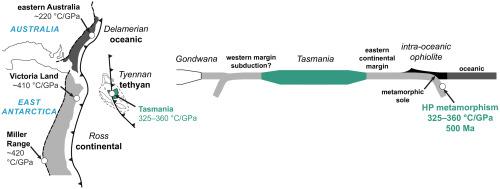Gondwana Research ( IF 6.1 ) Pub Date : 2021-03-03 , DOI: 10.1016/j.gr.2021.02.015 Dillon A. Brown , Martin Hand , Laura J. Morrissey

|
Evidence for high-pressure metamorphism along the Cambro-Ordovician East Gondwana margin is limited to occurrences of eclogite-facies rocks in the central Transantarctic Mountains, northern Victoria Land, western Tasmania, and eastern Australia. The western Tasmanian eclogites in the Franklin Metamorphic Complex are enclosed by high-grade metapelitic lithologies and contain a high-pressure mineral assemblage of garnet + omphacitic clinopyroxene + pargasitic amphibole + phengite + quartz + rutile + clinozoisite. Mineral relationships and compositions in the eclogites, combined with mineral equilibria forward modelling, indicate the eastern margin of Tasmania was subducted along a relatively cold thermal gradient to pressures between 18 and 21.5 kbar at temperatures of 650–700 °C. LA–ICP–MS U-Pb analysis of zircon yields middle Cambrian ages, consistent with previous geochronology, as well as older Mesoproterozoic ages. Rare earth element concentrations in Cambrian-aged zircon suggest they formed at high pressures whereas Mesoproterozoic-aged zircon formed at lower pressures. Garnet preserves elemental concentrations consistent with prograde growth, with middle and heavy rare earth element concentrations resolving a complex growth history involving the consumption of clinozoisite and apatite. In-situ rutile LA–ICP–MS U-Pb ages are early to middle Cambrian and indicative of prograde to peak growth during subduction, with Zr concentrations in matrix rutile yielding upper-amphibolite-facies temperatures. In this contribution, the pressure-temperature (P–T) results for the western Tasmanian eclogites revise existing conventional thermobarometric P–T data. The updated thermal gradient information can be more precisely allied with subduction zone thermal models, which provide predictions of the thermal structure of the subduction geodynamic system. Furthermore, when integrated with the mineral equilibria and P–T data from other eclogites along the margin, these results expand upon the existing interpretations of the geodynamic character of the Cambro-Ordovician East Gondwana margin.
中文翻译:

塔斯马尼亚州西部榴辉岩的锆石岩石年代学和矿物平衡:询问早古生代东冈瓦纳俯冲记录
坎布罗-奥陶纪东部冈瓦纳边缘的高压变质证据仅限于中跨南极山脉,维多利亚州北部,塔斯马尼亚州西部和澳大利亚东部的榴辉岩相岩发生。富兰克林变质带中的塔斯马尼亚西部的榴辉岩被高品位的成岩岩性所包围,并包含石榴石+斜长石斜辉石+斜长角闪石+锂铁矿+石英+金红石+斜长石的高压矿物组合。榴辉岩中的矿物关系和成分,再加上矿物平衡的正演模拟,表明塔斯马尼亚岛的东缘在650-700°C的温度下沿相对较冷的热梯度俯冲到18至21.5 kbar的压力。锆石的LA–ICP–MS U-Pb分析可得出中寒武世年龄,与以前的年代学以及中古生代年龄相一致。寒武纪年龄的锆石中的稀土元素浓度表明它们是在高压下形成的,而中元古代的锆石是在较低的压力下形成的。石榴石保留与渐进生长一致的元素浓度,中,重稀土元素浓度解决了复杂的生长历史,涉及消耗斜长石和磷灰石。原位金红石型LA–ICP–MS U-Pb年龄早于中寒武世,表明俯冲过程中已升至峰值生长,基质金红石中的Zr浓度会产生上闪闪石相的温度。在这一贡献中,压力-温度 寒武纪年龄的锆石中的稀土元素浓度表明它们是在高压下形成的,而中元古代的锆石是在较低的压力下形成的。石榴石保留与渐进生长一致的元素浓度,中,重稀土元素浓度解决了复杂的生长历史,涉及消耗斜长石和磷灰石。原位金红石型LA–ICP–MS U-Pb年龄早于中寒武世,表明俯冲过程中已升至峰值生长,基质金红石中的Zr浓度会产生上闪闪石相的温度。在这一贡献中,压力-温度 寒武纪年龄的锆石中的稀土元素浓度表明它们是在高压下形成的,而中元古代的锆石是在较低的压力下形成的。石榴石保留与渐进生长一致的元素浓度,中,重稀土元素浓度解决了复杂的生长历史,涉及消耗斜长石和磷灰石。原位金红石型LA–ICP–MS U-Pb年龄早于中寒武世,表明俯冲过程中已升至峰值生长,基质金红石中的Zr浓度会产生上闪闪石相的温度。在这一贡献中,压力-温度 具有中等和重度稀土元素浓度,解决了复杂的生长历史,涉及消耗斜长石和磷灰石。原位金红石型LA–ICP–MS U-Pb年龄早于中寒武世,表明俯冲过程中已升至峰值生长,基质金红石中的Zr浓度会产生上闪闪石相的温度。在这一贡献中,压力-温度 具有中等和重度稀土元素浓度,解决了复杂的生长历史,涉及消耗斜长石和磷灰石。原位金红石型LA–ICP–MS U-Pb年龄早于中寒武世,表明俯冲过程中已升至峰值生长,基质金红石中的Zr浓度会产生上闪闪石相的温度。在这一贡献中,压力-温度塔斯马尼亚西部榴辉岩的(P–T)结果修改了现有的常规热压P–T数据。更新后的热梯度信息可以与俯冲带热模型更精确地关联,该模型可以提供对俯冲地球动力学系统热结构的预测。此外,当与矿物平衡和集成对叔沿着余量其他榴辉数据,这些结果在所述寒武-奥东冈瓦纳余量的动力学性质的现有的解释扩大。



























 京公网安备 11010802027423号
京公网安备 11010802027423号